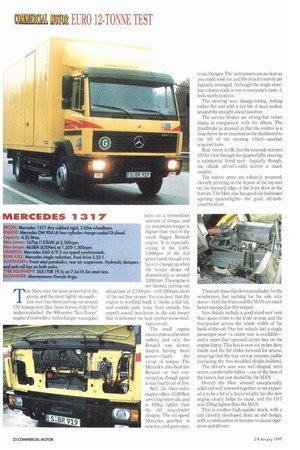T he Mere was the least powerful of the group, and
Page 24

If you've noticed an error in this article please click here to report it so we can fix it.
the most highly stressed----just over four litres putting out around 170 horsepower. But those horses didn't feel undernourished: the 900-series "Eco Power" engine (fitted with a turbocharger wastegate)
puts out a tremendous amount of torque, and its maximum torque is higher than that of the much bigger Renault engine. It is especially strong in the 1,4001,90Orpm of the full green band, though you have to change up when the torque drops off dramatically at around 2,000rpm. The engine is rev-limited, cutting out altogether at 2,700rpm—still 200rpm short of the red line proper. You can hear that the engine is working hard; it throbs a fair bit, and sounds quite noisy from outside, but superb sound insulation in the cab meant that it delivered the best interior noise readings overall.
The small engine means that acceleration suffers, and only the Renault was slower, despite having more power—that's the virtue of torque. The Mercedes also beat the Renault on fuel consumption, though again it was fourth out of five.
Still, the three-valve engine offers 45,000km servicing intervals, and is 100kg lighter than the old six-cylinder designs. The six-speed Mercedes gearbox is new too, and gave easy, crisp changes. The instruments are as clear as you could wish for, and the minor controls are logically arranged. Although the single steering-column stalk is not to everyone's taste, it feels nicely positive.
The steering was disappointing, feeling rather flat and with a fair bit of dead motion around the straight-ahead position.
The service brakes are strong but rather sharp in comparison with the others. The handbrake is unusual in that the control is a long-throw lever mounted on the dashboard to the left of the steering wheel—another acquired taste.
Rear vision is OK, but the nearside mirrors fill the view through the quarterlight, creating a substantial blind spot—logically though, the offside (driver's-side) mirror is much smaller.
The mirror arms are robustly mounted, cleverly pivoting on the A-post at the top and on the forward edge of the front door at the bottom. The Merc also has good old-fashioned
opening quarterlights for good old-fashioned fresh air.
There are three flip-down sunshades for the windscreen, but nothing for the side windows—both the Iveco and the MAN are much better equipped in this respect.
Nice details include a good-sized roof vent that opens either to the front or rear, and the tray/pocket across the whole width of the back of the cab. Our test vehicle had a single passenger seat—a centre seat is available— and a super (hut optional) centre box on the engine hump. This box is over six inches deep inside and the lid slides forward for access, ensuring that the tray on top remains usable (including the two moulded drinks-holders).
The driver's seat was well-shaped, with warm, comfortable fabric—one of the best of the bunch, but just shaded by the MAN.
Overall the Merc seemed exceptionally solid and well screwed-together, so we expected it to be a bit of a heavyweight; but the new engine clearly helps its cause, and the 1317 was 250kg lighter than the MAN.
This is another high-quality truck, with a cab cleverly developed from an old design, with a combination of features to please operators and drivers.
















































































